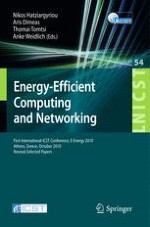2011 | Buch
Energy-Efficient Computing and Networking
First International Conference, E-Energy 2010, Athens, Greece, October 14-15, 2010, Revised Selected Papers
herausgegeben von: Nikos Hatziargyriou, Aris Dimeas, Thomai Tomtsi, Anke Weidlich
Verlag: Springer Berlin Heidelberg
Buchreihe : Lecture Notes of the Institute for Computer Sciences, Social Informatics and Telecommunications Engineering
